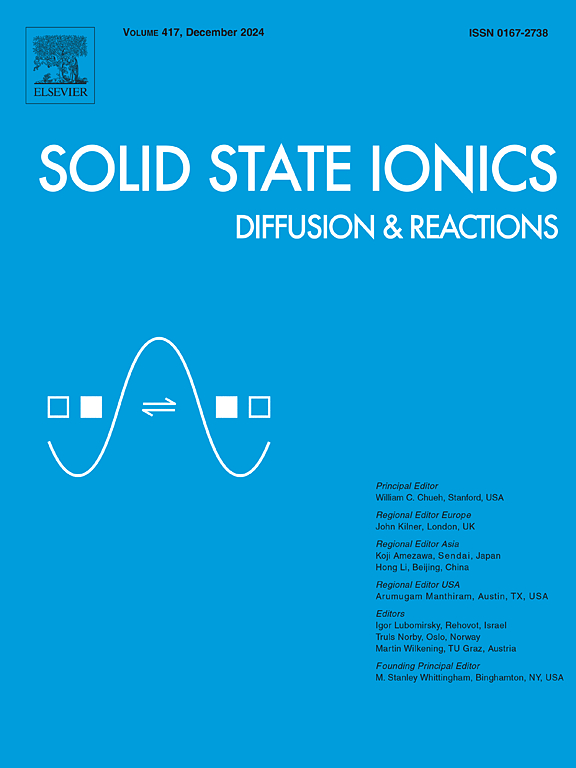Tuning lithium diffusion by anionic substitution in a trigonal halide superionic conductor
IF 3.3
4区 材料科学
Q3 CHEMISTRY, PHYSICAL
引用次数: 0
Abstract
Halide solid electrolytes have emerged as a key enabler for solid-state batteries, offering exceptional electrochemical and mechanical compatibility with cathodes. Among them, Li2ZrCl6 stands out as a cost-effective alternative, unlike most reported halide electrolytes that rely on scarce and expensive elements such as Y, Er, Ho, Sc and Yb. However, its relatively low ionic conductivity (∼10−4 S cm−1) remains a critical limitation for practical applications. In this study, we employ a theoretical approach to unravel the lithium diffusion mechanisms in trigonal Li2ZrCl6 and systematically evaluate the effect of partial anion substitution on ionic transport. Our findings reveal that even minimal amount of anion (e.g., sulfur) substitution can drastically enhance lithium percolation pathways, significantly accelerating lithium diffusion kinetics. This enhancement stems from a unique in-plane diffusion mechanism, where electrostatically restricted vacant sites at pathway intersections – previously inaccessible – become activated through anion substitution. In particular, sulfur mitigates cationic repulsion and enlarges intermediate sites at these intersections, unlocking multiple new diffusion pathways. Guided by this insight, we experimentally demonstrate that even a minimal level of sulfur substitution (∼3 %) increases ionic conductivity by a factor of three compared with pristine Li2ZrCl6. Further tuning achieves a remarkable conductivity of ∼1.33 10−3 S cm−1 at 25 °C, the highest reported for Li2ZrCl6 electrolytes 90 % Zr content. These findings highlight the structural adaptability of trigonal Li2ZrCl6 for anion substitution, presenting a new and effective strategy to achieve high ionic conductivity in cost-effective halide solid electrolytes.
用阴离子取代调节锂在三角卤化物超离子导体中的扩散
卤化物固体电解质已成为固态电池的关键推动因素,与阴极具有优异的电化学和机械兼容性。其中,Li2ZrCl6作为一种具有成本效益的替代品脱颖而出,不像大多数报道的卤化物电解质依赖于稀缺和昂贵的元素,如Y, Er, Ho, Sc和Yb。然而,其相对较低的离子电导率(~ 10−4 S cm−1)仍然是实际应用的关键限制。在本研究中,我们采用理论方法揭示了锂在三角形Li2ZrCl6中的扩散机制,并系统地评估了部分阴离子取代对离子传输的影响。我们的研究结果表明,即使是极少量的阴离子(如硫)取代也能显著增强锂的渗透途径,显著加速锂的扩散动力学。这种增强源于一种独特的平面内扩散机制,在这种机制中,以前无法进入的路径交叉处的静电限制空位点通过阴离子取代被激活。特别是,硫减轻了阳离子排斥并扩大了这些交叉点的中间位点,解锁了多种新的扩散途径。在这一见解的指导下,我们通过实验证明,与原始Li2ZrCl6相比,即使是最低水平的硫取代(~ 3%)也能将离子电导率提高三倍。进一步调谐在25°C时获得了显著的电导率~ 1.33 × 10−3 S cm−1,这是Li2ZrCl6电解质Zr含量≥90%时报道的最高电导率。这些发现突出了三角形Li2ZrCl6对阴离子取代的结构适应性,为在经济高效的卤化物固体电解质中实现高离子电导率提供了一种新的有效策略。
本文章由计算机程序翻译,如有差异,请以英文原文为准。
求助全文
约1分钟内获得全文
求助全文
来源期刊

Solid State Ionics
物理-物理:凝聚态物理
CiteScore
6.10
自引率
3.10%
发文量
152
审稿时长
58 days
期刊介绍:
This interdisciplinary journal is devoted to the physics, chemistry and materials science of diffusion, mass transport, and reactivity of solids. The major part of each issue is devoted to articles on:
(i) physics and chemistry of defects in solids;
(ii) reactions in and on solids, e.g. intercalation, corrosion, oxidation, sintering;
(iii) ion transport measurements, mechanisms and theory;
(iv) solid state electrochemistry;
(v) ionically-electronically mixed conducting solids.
Related technological applications are also included, provided their characteristics are interpreted in terms of the basic solid state properties.
Review papers and relevant symposium proceedings are welcome.
 求助内容:
求助内容: 应助结果提醒方式:
应助结果提醒方式:


